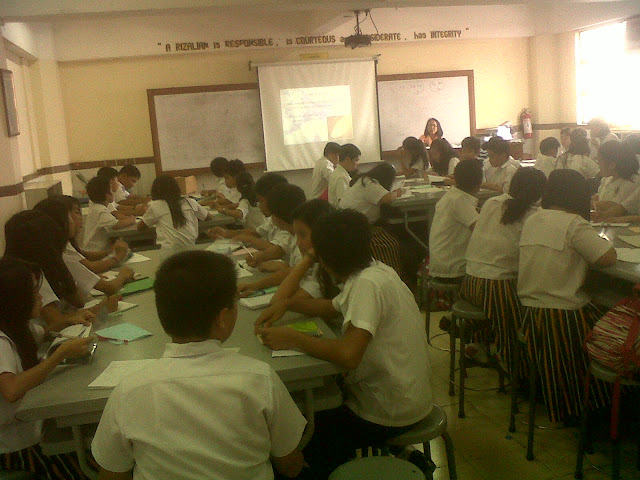Last week I was in Manila, doing some work for the Asian Development Bank. Part of our introductory tour involved going on a school visit, and since one of the chief reasons for me starting this blog was to capture and record some of these school visits, I include some photos and some of my personal impressions below.
The school we visited was a high school called
Jose Rizal University High School which is part of the University and College campus complex, offering education right from Elementary level, through High School and into College, University, and Post-Graduate level. It turns out that it's more common for Higher Education Institutes within the Philippines to diversify upstream, as it were, and run High Schools or younger to help feed the main University or simply as part of a general community building activity.
On the way to school we saw some wonderfully colourful Jeepneys, which are the public buses running around Manila and decorated in idiosyncratic style by their drivers. We also came across a couple of yellow school buses - I wonder where it was decreed that all school buses in whatever part of the world you're in MUST BE YELLOW?
 |
| A Jeepney - notice the strong Catholic flavour! |
 |
| School bus within JRU's courtyard. |
We arrived about 2pm just as afternoon lessons were beginning, and were given a very hearty welcome by the Principal, who informed us that there were about 1,600 students enrolled and about 45 teaching staff.
 |
| Outside the Principal's office, a picture board of all 45 teaching staff, organised by subject. |
 |
| Yours truly standing with the School Principal. |
 |
| Office of the VP for Basic Education, round the corner and in same corridor as main University Campus building. |
 |
| Looking down on self-organised student rehearsal, in the concrete courtyard. |
 |
| First floor corridor, row of classrooms on the left. |
 |
| View of School's east wing, and high rise apartment's just opposite school. |
The average class size in the school is around 50 students per teacher. The few classes we saw did tend to have a teacher at predominantly at the front of the class, with some fairly tightly-pressed students sitting in rows. Student engagement seemed decent enough, and c.80% of the 25 or so classrooms had projectors and smartboards.
 |
| A chemistry lesson in progress - 50 odd students and a smartboard. |
 |
| Some girls pleased about their Physics Laboratory! |
 |
| Helpful signs to differentiate which class I'm meant to be going to. |
 |
| A biology lesson in progress. |
 |
| School Computer Lab. |
 |
| One of 3-4 e-monitors mounted by the school staircase or in the hallways, that scrolled information about the day's news, or links to school website, or announcements about lost property etc. Quite a nifty information system for students. |
My general impression was of a well-run school environment where kids appeared friendly and fully engaged. Two members of staff had been teaching there for 23 years a piece, and their attitude about the school's mission and place in the community was highly positive. The picture below shows the price range for the primary level students.

It's hard to read, but the picture lists tuition fees at between 18,000 to 22,000 Pesos per student per year (for Grades K to 6 in this case). That's a remarkable $400-$550 USD per year price point. We didn't get to see any hard examinations data but were told anecdotally that students did well and the school outperformed some of its local state school competitors. About 400 of the attending students are part of the government's subsidised Education Service Contract (ESC) scheme, whereby lower-income families can get a student place paid for at a private school up to 10,000 pesos per annum, and then pay a top-up fee to make up the difference. The scheme was introduced many years ago as part of a policy to reduce the supply-side crunch and pull local private sector schools into the mainstream system.
Another advantage the school has of being part of the University campus, is that it gets access to the shared sports facilities (see below):
 |
| School gym. |
 |
| College students prepare to play basketball. |
 |
| Part of the large sports hall facility. |
JRU High School is planning on expanding next year, and has already identified the parcel of land next door in which the capital works will begin. I'd very much like to thank all the staff and students who hosted me and my colleagues during the school, and I wish them the best of luck with the expansion plans!
 |
| The construction site next door where JRU High School's extension may be built. |
 |
| A view of the neighbouring streets of Mandaluyong City surrounding the school. It's an inner-city school within one of the central urban districts of Metro Manila. |

























No comments:
Post a Comment